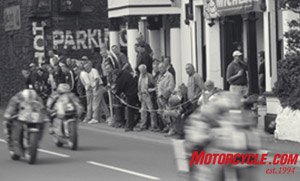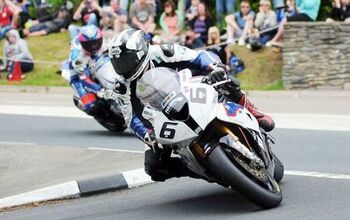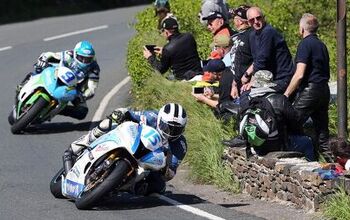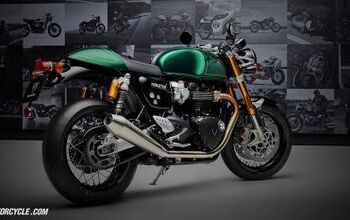Isle of Man TT 2008 Wrap-up
For fans of racing on real roads – as opposed to manicured race circuits – the universe of motorcycle racing can be neatly broken down into three categories: At the top, there is the Isle of Man TT; just below that, the handful of other pure-roads races; and far below that, everything else, whether it’s MotoGP, SBK – or PlayStation.
The Isle of Man is a tiny island in the middle of the Irish Sea, between England and Ireland. Every year for over a century, this small independent nation has closed its main roads to traffic and held a week of motorcycle racing, through it’s biggest city, around much of the Island, and straight over the top of the highest mountain.
For much of its history, the Isle of Man TT was the British motorcycle Grand Prix. Riders like Mike Hailwood didn’t feel they’d really reached the top of the heap until they’d won on famed “Mountain Course” on the Isle of Man, a 37.75-mile public-roads circuit that famed broadcaster Murray Walker once called “the ultimate challenge in motorsport.” In the early 1970s, riders in the World Championship boycotted the event because of the massive dangers inherent in racing on a circuit lined with telephone poles, trees, stone fences and buildings. If you crash here, the odds of walking away unhurt are slim. Statistically, about 1% of all the racers who arrive here each year will leave in a box. Seriously. Well over 150 riders have been killed on the Mountain Course.
The World Championship boycott could have signaled the end of the TT, but somehow the event carried on, drawing larger and larger crowds and maintaining its legendary status. A new breed of pure-roads specialist, embodied in Joey Dunlop, raced faster and faster bikes around a course with hundreds of turns. It takes years of racing here to come close to mastering it, and anyone who ever tells you he’s put in a perfect lap is simply lying.
The fans don’t come out of morbid curiosity though. They come because they want to see racing on the sort of real roads they ride on themselves. And because at the TT, they can sit right on the edge of the course. Nothing you’ve ever seen can prepare you for standing on the sidewalk in the town of Kirkmichael while superbikes come past, wide open, close enough to you that if you spill your beer you’ll wet the course.
It’s something that every real motorcyclist has to see at least once in his (or her) life. Words can’t describe it – either the racing or the round-the-clock biker party. You’ve got to see it for yourself, and you’ve missed it again for this year.
Racing on the famous Isle of Man “Mountain Course” has drawn to a close in 2008 with the traditional “Senior” race. This year’s TT got off to a blustery, wet practice week. Most competitors could have used a few more practice laps. But the week of races ran in mostly good weather.
The TAS Suzuki team, backed by energy drink Relentless, looked indomitable in the first few races. The team’s riders Cameron Donald (Australia) and Bruce Anstey (New Zealand) finished first and second in the Dainese Superbike TT race. Adrian Archibald made it an all-GSX-R1000 podium.
'It’s something that every real motorcyclist has to see at least once in his (or her) life.'
Cameron Donald won the next race, too, which was the Scottish Life International Superstock TT (also for 1000cc machines.) That race was not an all-GSX-R affair though; John McGuinness and up-and-coming Guy Martin finished second and third on Honda CBR1000RRs, and Kawasaki and Yamaha-mounted riders also figured on the leaderboard.
TAS Suzuki’s Anstey rode his GSX-R600 to victory on the Mountain Course in the first of the 600cc Supersport races, only to have the win taken from him in post-race scrutineering. It was determined that his bike had an illegal cam. Steve Plater inherited the win, with McGuinness (Padgett’s Manx Gax Racing) again second on a Honda.
Two days later, Anstey proved he hadn’t needed a hot cam to win in the Supersport class. He won the second race for the 600s and set a new lap record of 125.359 mph in the process. Ian Hutchinson and Ryan Farquahar followed, on Yamaha and Kawasaki, respectively.
The Senior race was, for years, a race for 500 Grand Prix class machines. Nowadays, it’s basically a second Superbike race in everything but name. Regardless, this year’s Senior was a stormer. John McGuinness got off to a good start on his Padgett’s/Manx Gas Honda CBR1000RR, but was taken aback when local hero Conor Cummins’ bike covered his windscreen with oil – especially disconcerting on a course lined with stone walls and phone poles!
Still, McGuinness was quickly on the pace, and had an amazing race with the TAS teamsters Anstey and Donald. The trio lapped within a few seconds of each other until the first pit stop (at the end of Lap 2.) Anstey’s race ended there, due to problems with his chain and clutch.
The Padgett’s crew turned a great stop for McGuinness into a four-second advantage over Donald, but the Aussie clawed back the time, and then some, over the next two laps. After the second round of pit stops, Donald was a few seconds ahead of McGuinness. Then, the TAS Suzuki rider put in a brilliant fifth lap to increase his lead to about seven seconds. That’s not much, but it should have been enough.
Crossing the start finish line with one lap to go, Donald looked down and saw some oil on his boots. Discretion got the better part of valor, and he chose to slow just enough (increasing his lap time by about a minute) to take a safe second.
McGuinness’ Senior TT victory was his 14th TT win, tying him with the great Mike Hailwood. Ian Hutchison completed the podium for AIM Yamaha.
Of course, sidecars also race at the TT. The driver-passenger pairing of Nick Crowe and Mark Cox won both of the races, with a machine powered by a 600cc Honda motor. Local hero Dave Molyneux, with passenger Dave Sayle, had a disappointing first race; they barely got started before being forced to retire with clutch problems. In the second race a few days later, though, Moly and Crowe had a duel that left scuff marks on both of their outfits.
Although the Formula 2-style sidecars raced at the TT are nothing like the outfits raced in the World Championship, reigning champs Tim Reeves and Patrick Farrance finished third in the first sidecar race. That was the first podium finish for a sidecar “newcomer” at the TT since 1978.
Official TT attendance figures are notoriously unreliable, but the general impression is that attendance has been strong this year. For example, Manx Telecom’s cellular network’s frequently been overwhelmed, so cell phones have been useful as timepieces, cameras and stopwatches only.
A new development this year was the presentation of the TT Loyalty Award. These engraved tankards (at least the Manx Dept. of Tourism & Leisure understands the fans’ drinking habits!) were given to about a dozen fans who’ve attended from 30 to over 60 TTs. One old fellow told a story about having a heart attack, then checking himself out of the hospital, delaying an urgently needed coronary bypass, to keep his consecutive TT streak alive.
Over the last few years – since the horrific death of TT star David Jeffries – the TT organizers have redoubled efforts to reduce the risks of racing on the Mountain Course. There’s a lot more air fence and padding visible around the course now than there used to be. And many areas are off limits to fans (which doesn’t make it any safer for racers, but reduces the overall risk.) The total number of rider-miles has been cut, too. There’s no more morning practice, and fields are kept a little smaller than they used to be.
“Pure” road racing will never be safe. The recent deaths of Martin Finnegan at the Tandragee 100 and Robert Dunlop at the Northwest 200 prove that, as if proof’s needed. But it is worth noting that for the first time in recent memory, a fortnight’s practice and racing was held on the Mountain Course, and no one was killed or even seriously hurt. No racers, that is. At least three fans were killed non-racing-related accidents, one of which involved riding on the wrong side of the road. Still, that’s fewer biker deaths than in a typical Daytona Bike Week (probably because the Manx Constabulary have no tolerance at all for riding without a helmet).
It was a disappointing TT for the American contingent. Mark Miller, riding an Ice Valley Mineral Water Yamaha R1, had even less practice than most, when he blew up a motor early in the fortnight. His team was able to borrow a motor from the top-flight AIM Yamaha crew, which Miller told us was working well leading up to the Superbike race.
“They wanted to change the clutch before the race,” he said. “Right off the start, I was being very careful with the clutch, but it just slipped and went right to redline. By the end of the first lap, it was toast.” Miller’s clutch problems continued in subsequent races. “I never even got to a pit stop all week.”
Despite that, he had good things to say about the team, even though he didn’t choose them. “My deal’s with the promoter. I basically just arrive with my helmet, and they put me on the best bike that they can arrange. (The team were) good guys, I liked them, and the bike handled great. It’s a shame we couldn’t make it work.”
Ex-AMA Superstock champion Jimmy Moore was expected to ride in several classes, with two different teams. When he arrived and didn’t like what he saw, he chose not to race at all. This is not a place to ride when you have any doubts about the quality of your machine preparation.
"I basically just arrive with my helmet, and they put me on the best bike that they can arrange."
One of the changes seen in recent years was the elimination of the 125GP “Ultralightweight” class and the 250GP/400 four-stroke “Lightweight” class from the TT schedule. That left a lot of the old guard pretty disgruntled.
Traditionally, the weekend after the TT races are held on the Mountain course, races are held on the 4.25-mile “Billown” course at the south end of the island, near Castletown. This year, the Ultralightweight and Lightweight races held on the Billown course are being called proper “TT” races.
There have been TT races held on other courses on the Isle of Man in the past, notably the 11-mile Clypse course, which was used for the smaller bikes between 1954-’59. If this marks the start of a new tradition and means we’ll continue to see the smaller displacement machines be part of the TT, it’s a good thing.
Mark Gardiner raced in the Isle of Man TT in 2002. He wrote about his experience on The Island in the book Riding Man.
Related Reading
Far-flung reporter: Letter from the Isle of Man
MO’s Trip to the USGP 2007
More by Mark Gardiner
































Comments
Join the conversation